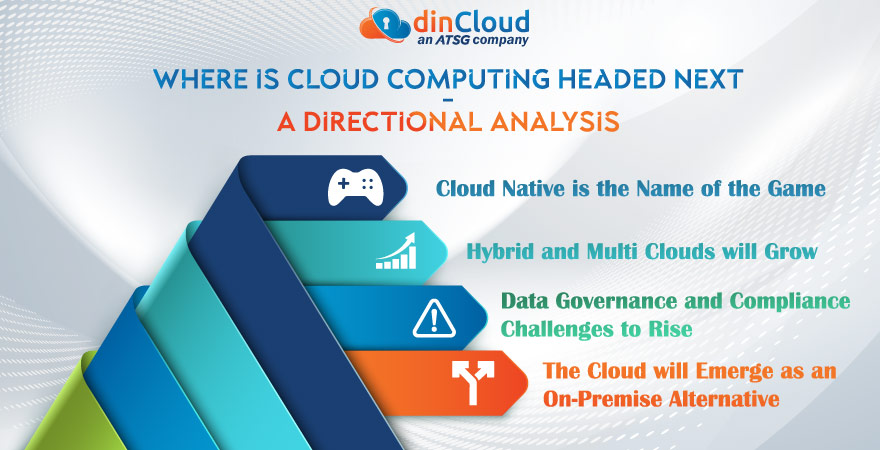Cloud Computing has constantly been evolving over the past years. In fact, the Cloud has been re-shaping enterprise processes and operations across many industries. This constant evolution of the Cloud has always been its major differentiator in the tech sector.
In this post, we will try to paint a picture of where Cloud Computing is headed in the near future, while also taking into account its current state.

Cloud Native is the Name of the Game
Not long ago, most enterprises were adopting a “lift and shift” approach to their cloud migrations. In this approach, the major change that enterprise processes experienced was that they simply moved from on-premise to somewhere in Cloud data centers.
Granted that this also fully qualifies to be a cloud migration, still, this approach is not the optimal one, when we talk of extracting the maximum business value out of cloud migrations. Hence, we are now moving towards an era of “cloud native”.
Related: Why you need Cloud Business Continuity and Disaster Recovery?
In this approach, enterprises just don’t arbitrarily shift their data, workloads and processes over to the infrastructure of a Cloud Service Provider (CSP) like dinCloud. Instead, enterprise processes are built from the ground-up, with a cloud centric approach.
By adopting this approach, enterprises are truly able to leverage the full-on flexibility, scalability and agility of the Cloud. This approach to cloud adoptions is proving of great value for enterprises, over the mid to long term.
Hybrid and Multi Clouds will Grow
The other major trend we expect to see even more in the near future is further proliferation of hybrid and multi cloud environments. This is because enterprises find themselves at much more ease when their cloud portfolio is well diversified.
One of the major reasons behind a hybrid and multi cloud approach is much better protection against the dreaded vendor lock-in. Enterprises will continue to keep their cloud portfolios well diversified by choosing multiple CSPs for their workloads.
Related: 10 Frequently Asked Questions (FAQs) about Cloud Computing
Data Governance and Compliance Challenges to Rise
With every passing day, we are witnessing an ever more increasing data governance and compliance/ related challenges. The impact of these stronger regulations is being felt by Cloud Service Providers (CSP) and deploying enterprises alike.
This does not mean that enterprises have lost their interest in the Cloud. The only thing that changes is that enterprises are now much more concerned where exactly their data resides, in terms of the location of their CSP’s data centers.
As a result, we expect to see the proliferation of much more localized, lower capacity data centers. Right now, most cloud providers are content with setting up large, centralized data centers, but this approach will have to change in the near future.
Instead, cloud providers will be channelizing more investments towards smaller capacity, localized data centers. With this approach, cloud providers will be able to tap into much more enterprise clients, which otherwise may not be comfortable with a transition.
With this approach of localized cloud data centers, regulators will also feel much more comfortable when enterprises move their sensitive data over to the Cloud. This approach will create a lot of harmony when it comes to meeting stringent regulations.
Related: What are the Financial Benefits of Moving to the Private Cloud?
The Cloud will Emerge as an On-Premise Alternative
Right now, most enterprise are perceiving cloud services as an extension of their on-premise IT infrastructures. What this means is that most enterprises were not prepared to completely “switch off” their on-premise infrastructures.
However, this approach is all set to change in a big way. With the rapid democratization of cloud services, and remarkably impressive track record in cyber security, it appears that the Cloud will emerge as a full scale alternative to on-premise IT infrastructures.
This in turn will enable the deploying enterprises to shift from a CapEx to a purely OpEx model. Enterprises will be able to scale their cloud environments up or down, on the fly, and pay only for the cloud resources that they actually end up using.
Related: Best Desktop as a Service (Daas) Provider
Conclusion
The global Cloud Computing industry is rapidly maturing, which is not only a good sign for Cloud Service Providers (CSP), but also comes as good news for enterprises that are on the lookout for agile and flexible IT operations, a hallmark of the Cloud.
Contact dinCloud, an ATSG company, for enterprise grade cloud computing solutions that are secure, reliable and cost efficient.


